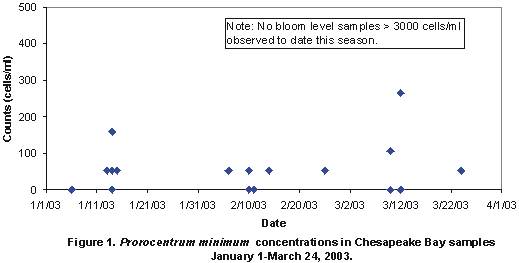|
April 14, 2003
Mahogany Tide organisms in low abundance in Chesapeake Bay tidewaters. |
|
Prorocentrum minimum is a common dinoflagellate in Chesapeake Bay tidal waters and is typically the main species responsible for Mahogany tides during our spring season. Between January and March 2003, the species has remained in low abundance (Figure 1) compared to bloom levels of 3000 cells/milliliter or more. A historical review of Maryland’s Chesapeake Bay phytoplankton monitoring data from 1985-2000 shows bloom levels are common in April and are most often observed in May (Figure 2). Bloom levels are less common during the summer and fall at the routine monitoring stations. Bloom conditions during the spring have been associated with at least 12 oC (53 oF) and almost exclusively in mesohaline salinities (5-18 ppt). Recent water temperatures during March and April 2003 were at record low conditions at Main Bay water quality monitoring stations located at the Bay Bridge (CB3.3C) and Mid-Bay (CB4.2C) (see more water quality data at Maryland DNR’s website Eyes on the Bay). This temperature pattern suggests spring conditions are lagging behind average years in the Bay. If bloom conditions leading to Mahogany tide are going to develop they are more likely to occur later in the spring if the present trend in cold and cloudy weather patterns persists. |


